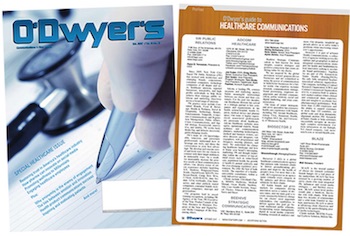|
|
Launching an innovative medical product into the marketplace is the moment of truth for so many: the R&D team that diligently pursued and perfected the science; the patients and families anxious for new treatment and new hope; the healthcare providers committed to bringing the best of medical innovation to people who can benefit.
For the communications team, it’s a moment of truth as well: will the product’s potential be understood and amplified by its key stakeholders, so that it reaches patients in need?
In today’s marketplace, the answer to that question depends on so much more than clear messaging regarding the product itself. Communicators must also consider the messengers, the channels, and how to leverage previous scientific success in a way that sets the tone for commercial success.
A new playing field
It used to be that drug and medical device innovators were the dominant intellectual forces and leading voices in the product discussion. From news media to medical meetings, the experts who discovered and developed the product were the natural, sought-after sources of information, and communications teams readily managed the messaging. Now, innovators are a step removed: stakeholders seek details—and outside perspective—from advocates and KOLs, often before consulting company scientists.
|
|
Today’s marketplace has turned product communications on its head in other ways, too. Media look at new medications as an expense (“how much will you charge?”), often forgetting the disease state has its own costs. The public is no longer willing to accept the story about a drug’s intellectual property value and contribution to medicine as justification for a high price tag. Even when R&D breakthroughs have impressed and inspired during the lead-up to approval, once the drug is ready for launch, stakeholders want to see how that clinical success translates to real-world application.
Savvy PR professionals understand this new dynamic: the driving question for key audiences, even those who are enthusiastic about the product’s potential, is “how do we know its true value?” The following three guideposts can help communicators demonstrate the patient need, the scientific proof points, and therefore, the unique value of the product.
1. First and foremost, remember the patient — don’t treat medical innovation like a media stunt. We may be stating the obvious, but communicators must remember, and honor, the reason their product was developed in the first place: addressing an unmet patient need. Consider the multiple players who have rallied around this shared mission, and how they might discuss the product launch: How can chief scientists help to set the tone for the brand? How can KOLs who led peer-review trials be part of the conversation? How might patient groups express the distinct need of their community? Each of these voices will help to show how the new product fulfills genuine patient demand.
Making a splash is tempting (and in some ways important!), but it won’t create lasting value. Recent years have seen examples of innovative medicines with high potential to address unmet needs — supported by high-visibility campaigns — whose science was exciting and meaningful, but whose market launch did not translate to physician and patient uptake. Celebrity campaigns can do wonders to raise awareness and educate the public, but increased understanding of a disease state doesn’t necessarily tie to a single brand. Rather than creating gimmicks to get media attention, successful brands connect authentically with the people they intend to help, and position those allies alongside any high-profile efforts. After all, it’s those voices that will help to build the case for product value and demand its availability; without the support of the patient community, even the most alluring celebrity advocates can’t generate product use.
2. Understand the difference between breakthrough science and breakthrough product — and what is needed to bridge from one to the other. Today’s health ecosystem draws a clear distinction between breakthrough science and breakthrough medicine. Increasingly, we see products that are lauded for their clinical innovation but nevertheless unable to gain a foothold in the market. While their contributions to our understanding of biology and medicine are tremendously important, sales won’t follow unless their unique role in patient care is clear and understood.
If science represents excitement about the approach — the MOA, the molecule, the discovery — then medicine is the pragmatic application of that science to meet the needs of the patient community. Reporters may be happy to write, with great enthusiasm, about breakthrough science before the product is reviewed and approved by regulatory bodies. But once that approval is achieved, the conversation turns from clinical understanding to population use.
When the discourse shifts from amazement about the science to the practicality of innovation in the patient community, PR teams must be well-prepared. Have you made clear that the benefit to the patient is not incremental, but rather matches the price and the amount of work required by patient and staff to properly utilize the medication? In many therapeutic categories now addressed by a pill or inhaler, biologics are being studied. In such cases, have you made the benefit clear enough to a patient and his or her doctor that they are willing to break an old habit and move to an injection, or will they think the pill is still “good enough”? Considering these questions ahead of time is critical to brand success.
3. Frame the discussion around value and access proactively. Lastly, understand that discussion in today’s environment will always include cost and value — and, importantly, that access is the foundation to understanding and accepting both.
Although marketing and PR professionals often focus on product visibility when planning and deploying support for launch and approval, the dynamic has shifted. Patients, physicians, policymakers and payers are eager to assess new products through the lens of “value.”
High visibility may garner positive metrics for news coverage and brand recognition, but it won’t translate to product success unless access to therapy is addressed clearly. If patients cannot obtain the product, or physician offices are frustrated by paperwork and prior authorization obstacles to providing the product to patients, uptake will suffer.
Launching in today’s market is complex, but success is possible with the help of thoughtful, savvy communicators. If the PR team can keep conversation centered on the unmet patient need — not merely product attributes — and, ultimately, demonstrate how and why the brand is central to the dialogue between patient, physician and payer, then success will follow.
***
Kristie Kuhl, JD, is a senior partner at Finn Partners’ Health Practice in New York. She can be reached at [email protected]. Arielle Bernstein Pinsof, MPP, is a partner at Finn Partners Health Practice in Chicago. She can be reached at [email protected].

 Kristie Kuhl and Arielle Bernstein Pinsof co-authored this article.
Kristie Kuhl and Arielle Bernstein Pinsof co-authored this article.

 Lo Isidro, senior director at Real Chemistry with more than a decade of strategic communications and PA experience, has joined Narrative Strategies.
Lo Isidro, senior director at Real Chemistry with more than a decade of strategic communications and PA experience, has joined Narrative Strategies. Nelson Fernandez, former North American chair of APCO Worldwide and managing director of Burson-Marsteller, has joined Volunteers in Medicine Berkshires as director of communications and PA.
Nelson Fernandez, former North American chair of APCO Worldwide and managing director of Burson-Marsteller, has joined Volunteers in Medicine Berkshires as director of communications and PA. Lilit Bargar, who was most recently an EVP in the healthcare practice at Weber Shandwick, comes on board at GCI Health as EVP, corporate practice lead.
Lilit Bargar, who was most recently an EVP in the healthcare practice at Weber Shandwick, comes on board at GCI Health as EVP, corporate practice lead.
 Five ways that successful thought leaders are made.
Five ways that successful thought leaders are made.


 Have a comment? Send it to
Have a comment? Send it to 
No comments have been submitted for this story yet.